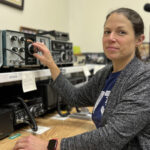Firefighters are called to respond to all types of emergencies – but not all of these calls for help end up being what they at first seem to be. Responding to a medical call, fire, or explosion, for example, at what turns out to be a clandestine drug lab (CDL) is becoming a more common problem – for which firefighters (and other responders) must prepare very, very carefully.
A CDL is any laboratory that manufactures illegal controlled drugs or substances. Such labs have been found in single and multiple family dwellings, motel rooms, campgrounds, mini-storage buildings, and even in the trunks of cars and/or other vehicles. Although CDLs are not new, they have become more widespread because of the easy availability of the chemicals and other supplies needed to make the drugs, as well as the ease of finding information on the Internet on how to produce or “cook” the drugs.
Although CDLs can be used to manufacture many varieties of illegal drugs, they are primarily used to manufacture different types of methamphetamines (meth). According to the U.S. Drug Enforcement Agency (DEA), more than 99 percent of the illegal labs found in the United States itself in 2008 were involved in some way to meth production, and more than 6,700 meth-lab incidents were reported that same year.
“Street” methamphetamine is referred to by several names – the most common being “meth,” “speed,” and “chalk.” Methamphetamine hydrochloride – clear chunky crystals, resembling ice, that can be inhaled by smoking – is usually referred to as “ice,” “crystal,” or “glass.” Whatever its external appearance, meth is basically a central nervous system stimulant, similar to cocaine, used to achieve “highs” lasting from 6 to 14 hours. Addicted users can experience several altered levels of consciousness that lead directly to irritability, anxiety, paranoia, nervousness, and a broad range of erratic behavior.
CDLs: Ubiquitous, Innocent Looking & Sometimes Incendiary
Responses to CDLs are often reported as other types of incidents, such as, but not limited to: medical-aid calls complete with burn or smoke-inhalation victims; structure and/or trash fires; and even explosions. A December 2011 explosion in an apartment in Jacksonville, Florida, revealed the presence of an operational CDL. The explosion literally lifted the ceiling off the wall, blew out windows, and scorched a tree outside the building – a number of the building’s residents also reported seeing a person “on fire” running from the scene.
Firefighters and other first responders should keep in mind that some meth labs are portable enough to fit into a backpack or the trunk of a car; in November 2011, in fact, police did find a meth lab in the trunk of a car while they were investigating “a suspicious vehicle” in the parking lot of a Jacksonville shopping mall. Responders also should not be surprised to come upon these portable labs at any traffic crash or while carrying out an everyday response to a “family residence,” apartment building, or any other structure.
When responding to these types of incidents, responders must maintain a high level of alertness at all times and, of course, proceed with extreme caution. The meth labs are extremely dangerous for a responder to approach without the proper equipment and training. Fire personnel must be particularly aware of the “common signs” and other evidence of a CDL: the burning and mixing together of the various chemicals used to manufacture meth create toxic gases that pose a potentially lethal threat to responders and anyone else living or working in the area close to the lab.
Duct Tape, Coffee Filters, Aluminum Foil, and Other Trash
There are several telltale signs that should alert responders to the possible presence of a CDL – excessive amounts of trash, for example, particularly chemical containers; also, large quantities of cold and/or allergy medications, coffee filters, pieces of red-stained cloth, rolls of duct tape. The fact that curtains are always drawn is another obvious clue, as are windows covered with aluminum foil, any signs of chemical waste or dumping, frequent visitors at unusual times of day (or night), and the use of extensive security measures.
Unusual odors also could be reason for concern. Various chemicals that are used in or are by-products of methamphetamine production – e.g., phosphine, ether, ammonia, battery acid, and/or acetone – all have distinctive odors. Phosphine smells like garlic, for example, sulfur like rotten eggs, ammonia like cat urine, and acetone like nail polish remover.
Armed suspects who may be under the influence of methamphetamine (which creates an induced paranoia) may be present at the lab. Among the other potential hazards are: (a) explosive vapors (from the chemicals used to manufacture the drugs); and (b) the dangerous mixtures of chemical materials with the potential to cause fires, create toxic fumes, or cause explosions. Moreover, because those running the lab obviously want to remain hidden, they may set various types of booby traps and/or use chemical devices or trip wires to keep out unwanted visitors.
The inhaling of toxic fumes may not only harm those who mix the chemicals, but also pose a danger to emergency responders, hazardous-materials clean-up crews, and neighbors. Common injuries can include respiratory and eye irritation, headaches, dizziness, nausea, and shortness of breath.
Here it is worth noting that the U.S. Department of Justice has warned about a significant environmental impact from CDL operations – namely, that each pound of manufactured methamphetamine produces an estimated 5-6 pounds of hazardous waste – which frequently is dumped into the sewers, streams, and rivers most conveniently located near the lab.
All Deliberate Speed, Maybe – But Safety First Always
Any time a scene appears to be suspicious, responders should take extra precautions to be sure that they themselves do not become victims. If the presence of a CDL is suspected, it should be approached from uphill, upwind, and upstream – if at all possible. The use of proper protective equipment, specifically including respiratory protection gear, is essential to avoid inhaling and/or being otherwise exposed to any toxic substances at or close to the lab. Moreover, if there is no immediate need to enter the structure, fire personnel would be well advised to wait until law enforcement arrives to secure the scene – and should also keep in mind that they may have stumbled upon a crime scene.
If a CDL is found after entering the structure, responders should try first to back out without touching anything – being aware at the same time of possible booby traps or other devices set to deter law enforcement and/or other uninvited visitors. After the lab or other structure has been secured, moreover, all responders should decontaminate themselves, and their clothing, to remove any toxic substances they may have come in contact with – the standard operating procedures postulated by various response agencies also should be consulted for further operations at the lab scene.
CDLs are not an obvious or omnipresent danger that fire personnel would expect to encounter on a regular basis, so responders may not necessarily notice all of the danger signs when responding to a call for service. Clandestine labs are concealed for a very specific reason – namely, that those running or operating an illegal lab do not want to be noticed. Emergency personnel must always remember, therefore, to “take a moment” to evaluate each and every situation very carefully and look for possible signs of trouble – and of personal danger – before continuing to make their way inside a potentially dangerous structure or facility. This common-sense approach applies even, and perhaps especially, on seemingly routine calls.

Christina Spoons
Christina Spoons holds a Masters in Public Administration with a concentration in Homeland Security and is currently completing her Ph.D. in the same discipline with a concentration in Terrorism, Mediation, and Peace, both from Walden University. Her emergency services experience includes several years as a Firefighter/EMT and instructor with the American Red Cross. She has been active in the development of firefighter curricula at both the state and national levels and also is involved with several National Fire Protection Association committees, including those focused on Firefighter professional qualifications and electronic safety equipment. She teaches homeland security and public policy and administration courses at Ashford University, and fire science courses at Columbia Southern University.
-
Christina Spoonshttps://www.domesticpreparedness.com/author/christina-spoons
-
Christina Spoonshttps://www.domesticpreparedness.com/author/christina-spoons
-
Christina Spoonshttps://www.domesticpreparedness.com/author/christina-spoons






